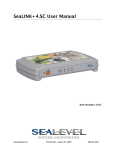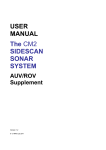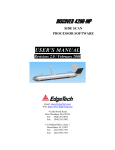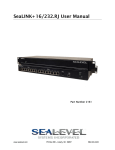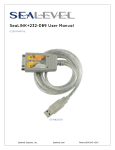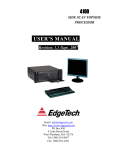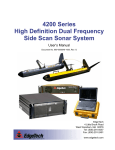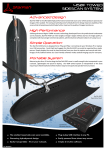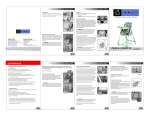Download USER MANUAL The CM2 SIDESCAN SONAR SYSTEM
Transcript
USER MANUAL The CM2 SIDESCAN SONAR SYSTEM Magnetometer Supplement Version 1.1 © C-MAX Ltd 2011 Contents CONTENTS 1. Introduction ………… 1 2. CM2-to-Magnetometer Interface ………… 2 CM2 System with Magnetometer Option Connection to SeaLINK Magnetometer settings 3. Connection, Deployment & Recovery ………… 4 Connecting the Magnetometer Launch and Recovery Operating the Magnetometer Using the CM2 Towfish without the Magnetometer connected Version 1.1 (2011) i Version 1.1 (2011) 1. Introduction 1. INTRODUCTION This supplement describes operation of the Marine Magnetics Explorer and SeaSPY magnetometers when towed behind a CM2 towfish, sharing the CM2's tow cable telemetry and power. This supplement should be read in conjunction with the CM2 User Manual and with Chapter 7 of the Explorer Operation Manual or SeaSPY Operation Manual. The primary advantage of operating the magnetometer with the sidescan interface is that it eliminates the need for a magnetometer tow cable. As well as being more convenient, sidescan tow cables usually have a better weight-to-drag ratio and the sidescan towfish acts as a depressor. The magnetometer can therefore be towed deeper, or with less layback, than on an independent tow cable. Version 1.1 (2011) 1 2. CM2-to-Magnetometer Interface 2. CM2-TO-MAGNETOMETER INTERFACE CM2 System with Magnetometer Option The CM2's Magnetometer Interface Kit option is intended to work with a Marine Magnetics Explorer or SeaSPY system that includes a Marine Magnetics sidescan sonar interface kit. When the CM2 system is ordered with the Magnetometer Interface Kit option it is delivered with the following items:1) A Magnetometer Link Cable 2) A towfish with a rear bulkhead that includes a fourth wet-pluggable connector (4-way, female) 3) A dummy plug to seal the fourth connector when the magnetometer is not attached 4) A D-shackle (6mm, long style) 5) A nylon sleeve The Magnetometer Link Cable connects the fourth bulkhead connector to the 8-way connector on the Marine Magnetics sidescan sonar interface cable. Connections in the magnetometer link cable are as follows:1 = +24V 2 = GND 3 = not connected 4 = RS232, to the CM2 towfish from the magnetometer 5-8 = not connected The fourth bulkhead connector carries an RS232 receive interface and a 24VDC supply. It is internally linked to socket J4 on the Towfish PCB. Its contacts must be sealed against the surrounding water whenever the CM2 towfish is deployed without the magnetometer being connected. The dummy plug is provided for this purpose. The D-shackle secures the universal joint on Marine Magnetics sidescan sonar interface cable to the CM2's tow cable terminator, as shown in the illustration. The nylon sleeve is permanently installed in the universal joint on the sidescan sonar interface cable to adjust the diameter to that of the shackle pin. Connection to SeaLINK If the magnetometer is operated independently, on its own dedicated tow cable, it requires a computer running Marine Magnetics' SeaLINK software and connected to the tow cable via an RS232 serial port. When the magnetometer uses the sidescan interface instead of being operated independently, the SeaLINK computer still acquires the magnetometer data via a serial port: however, instead of being connected directly to a tow cable, this port must now be connected, via a null modem cable, to the computer running MaxView or third-party sonar acquisition software. The magnetometer data is automatically extracted from the cable telemetry and passed via the serial port to SeaLINK. The magnetometer messages to SeaLINK are unchanged when they pass through the CM2 telemetry, with the conditional exception of the depth message. If the sidescan towfish is fitted with a depth sensor then the depth of the sidescan towfish is copied into the magnetometer depth message. A USB-to-serial converter may be needed if the sonar acquisition computer has no suitable serial port. As an alternative to using two computers, both MaxView and SeaLINK can run together on the same computer using a software null modem. This is likely to need a second screen for satisfactory operation. Version 1.1 (2011) 2 2. CM2-to-Magnetometer Interface Magnetometer settings The magnetometer baud rate and sample rate should be 9600 and 1Hz respectively, the factory default settings. The data string is also the standard, factory default format. Settings can only be adjusted or reset to default when the SeaLINK computer is connected directly to the magnetometer. The CM2 telemetry does not allow downward communication with the magnetometer. Version 1.1 (2011) 3 3. Connection, Deployment and Operation 3. CONNECTION, DEPLOYMENT AND OPERATION Connecting the Magnetometer Before initial use press the nylon sleeve into the 9.8mm (0.385") diameter hole in the universal joint tow connector on the free end of the Marine Magnetics sidescan interface cable. This sleeve has an inner diameter to suit the removable pin in the D-shackle. Use the D-shackle to attach the sidescan interface cable to the shackle on the CM2 tow cable terminator. The 8-way connector on the interface cable will then project to one side, either to the left or the right. Ensure that the shackle pin is screwed fully home. Attach the CM2 magnetometer link cable between the fourth connector on the rear bulkhead of the CM2 towfish and the 8-way connector on the Marine Magnetics sidescan interface cable. Connecting the Magnetometer (Explorer shown) Strap the magnetometer link cable to the CM2 towfish safety lanyard using plastic cable ties as shown in the illustration. This is important because, if the link cable is not secured in this way, hydrodynamic drag on the link cable may pull the plug out of the socket on the rear bulkhead. Before tightening the cable ties ensure that the magnetometer link cable does not come under tension the towing bail is fully forward. Version 1.1 (2011) 4 3. Connection, Deployment and Operation To test the system before launch start MaxView (or third-party sonar acquisition software) and SeaLINK, then start the CM2 towfish. After a delay of a few seconds power will be automatically applied to the magnetometer and sampling will begin. Launch and Recovery The magnetometer towfish and its sidescan interface cable are relatively buoyant. This means that at survey speeds the altitudes of the magnetometer and CM2 towfish are similar. It also means that the magnetometer can be launched first or last depending on preference. Refer to the CM2 User Manual for advice on launching the sidescan towfish. Lower the magnetometer towfish into the water. CAUTION: DO NOT DROP THE MAGNETOMETER TOWFISH INTO THE WATER OR ALLOW IT TO IMPACT THE TOWING VESSEL. When recovering, it is normally more convenient to recover the CM2 towfish first. Operating the Magnetometer Consult the magnetometer operation manual. Note that the optimum altitude and line spacing for the magnetometer will probably not be optimum for sidescan sonar and vice versa. A compromise is normally required. Using the CM2 Towfish without the Magnetometer connected CAUTION: IF THE CM2 TOWFISH IS USED WITHOUT THE MAGNETOMETER THE 4-WAY CONNECTOR ON THE REAR BULKHEAD OF THE CM2 TOWFISH MUST BE SEALED USING THE DUMMY PLUG. The CM2 towfish automatically disconnects the power to the magnetometer connector if the magnetometer has not responded within approximately 10 seconds. This protective mechanism is intended to prevent further electrolytic corrosion of the connector if the dummy plug has been accidentally omitted: it is not a substitute for proper use of the dummy plug. © C-MAX Ltd 2011 Version 1.1 (2011) 5 (This page intentionally blank) Version 1.1 (2011) 6












